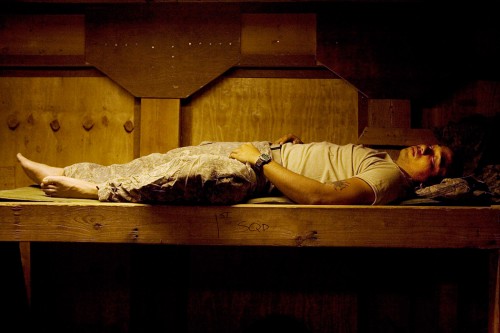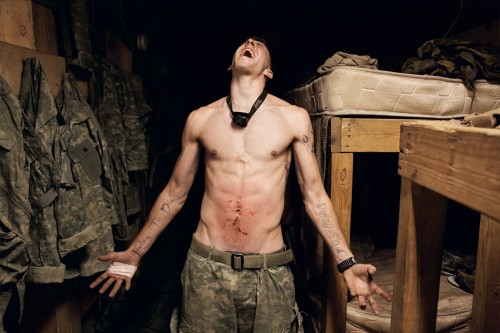
Tim Hetherington. "Nevalla, Korengal Valley, Kunar Province, Afghanistan," 2008. Digital C-Print. © Tim Hetherington, courtesy Yossi Milo Gallery, New York.
In her 2002 article “Looking at War: Photography’s View of Devastation and Death,” the late critic Susan Sontag considered the capacity of war photography to mobilize and affect the viewer, and whether such images might circumscribe our comprehension of events by functioning in the popular imagination as defining, yet only partial, evidence of an event. Sontag does not deny the seductive power of a war photograph’s immediacy and authority, citing several canonical instances when images of war moved opinion, catalyzed sentiment, or bore witness to seemingly climactic events (for example, Nick Ut’s iconic 1972 photograph of Vietnamese children running down a road after their village had been bombed with napalm).
“The problem,” Sontag contends, “is not that people remember through photographs but that they remember only the photographs.”[1] A war photograph’s symbolic and emotive power is problematic, she concludes, insofar as it offers concision to what can only be our vicarious experience of the enormity and intensity of war: “We [as viewers] don’t get it. We truly can’t imagine what it [war] was like. We can’t imagine how dreadful, how terrifying war is—and how normal it becomes. Can’t understand, can’t imagine. That’s what every soldier, every journalist and aid worker and independent observer who has put in time under fire and had the luck to elude the death that struck down others nearby, stubbornly feels. And they are right.”[2] On some level the viewer must generalize from the particular, processing images of war by summoning forth more universalizing responses drawn from culture, and thus comprehending the images by contextualizing them within more readily relatable experiences and understandings.
Photojournalist Tim Hetherington has captured the experience of war through images like few others have. The intensity of his photographs, however, rests in how they convey something of the realities of war precisely by not distilling to it down to the heroic or horrific climax of battle or some other decisive moment. Rather, his photographs of war, several of which are currently on view at Yossi Milo Gallery in Chelsea, seem to resist any straightforward solicitation of stock sensations and emotional responses—outrage or sorrow, sympathy or antipathy—that might allow viewers to relate to and appreciate the moment depicted. After all, as Sontag mused, how can we fully grasp such moments vicariously, and is there not something glib in thinking it possible?

Tim Hetherington. "Untitled, Liberia," 2003. Digital C-print. © Tim Hetherington, courtesy Yossi Milo Gallery, New York.
The photographs and captivating videos on view at Yossi Milo were taken by Hetherington during the Liberian civil war and while with American soldiers stationed in Afghanistan’s Korengal Valley during 2007-2008. The footage from his extended stay with US troops in Korengal became the basis for Restrepo, the 2010 award-winning documentary film that he co-directed with Sebastian Junger. The suite of photographs on view from Hetherington’s time in Korengal consists primarily of images of sleeping American soldiers. Laid out on spare plywood bunks, the soldiers are shown fast asleep, curled in a variety of positions and surrounding by various objects of distraction, domesticity and normalcy: magazines, books and music players.
These images of sleeping soldiers are haunted by stillness, and they prompt more questions than they seem to answer: are they exhausted in the aftermath of some intense firefight, or are they sleeping in anticipation of one that is forthcoming? Perhaps it is both. Within the discursive space of the war photograph, Hetherington’s images offer no clear response or interpretive refuge. What is more, one begins to suspect that there is no decisive answer forthcoming. Through their symbolic ambiguity, these images resist our desire to generalize from the particular—to perceive such images of war through a scrim of prescribed meaning by summoning forth more universalizing responses drawn from culture, and perhaps from the iconography of war photography, in order to more fully comprehend them.

Tim Hetherington. "Lizama, Korengal Valley, Kunar Province, Afghanistan," 2008. Digital C-print. © Tim Hetherington, courtesy Yossi Milo Gallery, New York.
Hetherington’s photographs defy the conventional depiction of war, and in doing so challenge how we as viewers process, think and understand conflict through images. His portraits and scenes are searing not because we can readily comprehend them as brutal, heroic, tragic or cathartic images, but precisely because they are documents of war that resist easy viewer identification and emotional response. And they are all the more powerful for it.
Tending to focus on the intervals between battle, Hetherington’s photographs of interstitial moments push back against our attempts to abstract concise meaning and find some emotional purchase. They are beautiful, compelling and finally unintelligible. And I mean that in the best sense. As placid as his images can be they are not simple; they remain complex and fraught with the weight of war, yet it is a weight without symbolic resolution to provide a foothold for easy comprehension. One will not find in Hetherington’s images the decisive moment of a bullet’s impact as one does in Robert Capa’s iconic 1936 photograph of a militiaman knocked off his feet at the moment of his death during the Spanish Civil War. Hetherington provides no such dramatic or symbolic encapsulation. His images instead seem to pose questions without obvious answers: how does one begin to understand and imagine the things that he witnessed, and the full context in which he documented it? How can one ever fully appreciate and record the enormity of these soldiers’ experiences, let alone distill it down to some decisive moment?
In a sense, Hetherington’s images might be viewed as meditations on the uses and meanings of photographic representation of war as much as they function as a documentation of war itself. His images don’t mobilize viewer responses by easy sympathy or provocation, but by keeping the viewing experience open, an openness that cannot be bridged by enough visual information or context or insight. How could one photograph or even a suite of images ever achieve this? It is through their status as the antithesis of straightforward and neatly unambiguous images of war that his photographs become memorable documents of the experience of war.

Tim Hetherington. "Specialist Tad Donoho, Korengal Valley, Kunar Province, Afghanistan," 2008. Digital C-print. © Tim Hetherington, courtesy Yossi Milo Gallery, New York.
This, I suspect, is the “stubborn feeling” to which Sontag was referring in 2002: not just that the actualities of war are made up of such decidedly “normal” moments as sleeping, but the impossibility of faithfully and fully transposing into images the intensity and the extremity that is the norm of war. Hetherington was killed along with fellow photographer Chris Hondros in Misrata in 2011 while covering the Libyan conflict. The body of work that endures as his legacy gestures to the impossibility of providing viewers with a full understanding of the realities of war, and the seemingly unwavering desire—need perhaps—on his part to continue to bear photographic witness. “We can never fully express the experience of war photographically and yet we must,” Hetherington seems to declare through his images. And he would be right.
[vimeo:https://vimeo.com/18497543]
Tim Hetherington, “Diary,” 2010. © Tim Hetherington, Courtesy Yossi Milo Gallery, New York
Tim Hetherington was on view at Yossi Milo Gallery in New York April 12 – May 19, 2012.



